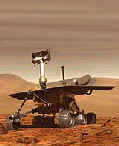Hybrid
Model-based Adaptive Systems :
NASA’s
Mars Exploration Rovers, Spirit and Opportunity, opened
the door for a new era of science based on insitu
science instruments, through extensive traverses and an
unprecedented level of science return.
However, at times these rovers needed to tip toe
at the edges of craters, while operators worried whether
or not the rovers would be able to return from exploring
a particularly interesting crater.
Capable autonomous vehicles must be much more
agile. Rovers
should be able to estimate soil traction and reorient
their center of gravity in order to safely move along
steep inclines. To
reach highly inaccessible locations, future legged
robots must be able to catch themselves as they stumble.
Likewise, exploration vehicles and automobiles
should be able to detect and diagnose failures during
their onset, when the earliest symptoms may be hidden
within the noise.

To
support these types of capabilities, our research has
focused on model-based adaptive systems.
First, a method called Gaussian Particle
Filtering was developed for robustly estimating and
tracking the continuous state of systems under different
operational regimes and under failure.
This method was applied to tracking the behavior
of a ball throwing, acrobatic robot and for detecting
the subtle failures of an advanced life support system
at Johnson Space Center.
Second, a method called conflict-directed Branch
and Bound was developed for efficiently solving
optimization problems that mix logical decisions with
continuous decisions involving linear constraints.
This method was demonstrated on cooperative air
vehicle path planning, based on simulations provided by
DARPA.
Our future research will explore methods for learning
hybrid discrete/continuous models through active
exploration, mission-directed cooperative path planners,
and hybrid methods for controlling and interpreting
humanoid motion.
Selected
Publications in this area:
| ![]()
